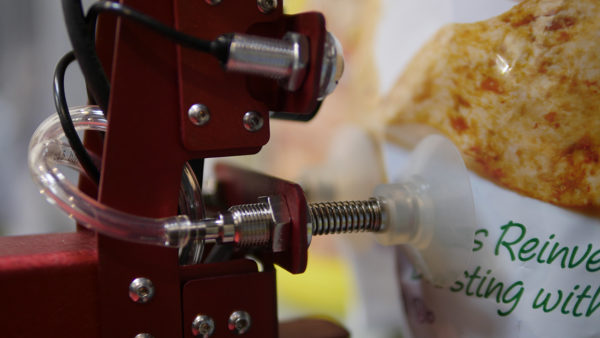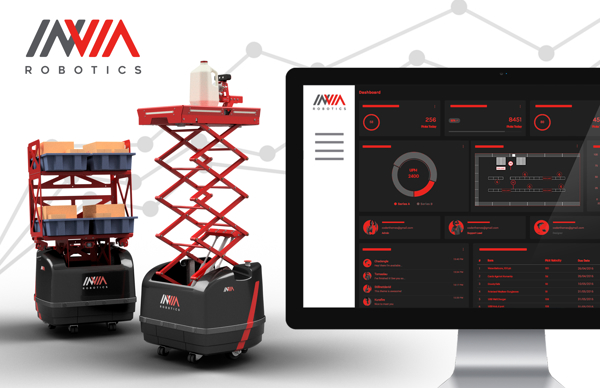InVia Robotics unveils warehouse robots

Warehouse automation startup inVia Robotics Inc. unveiled a pair of mobile order-picking robots on Tuesday, saying they will allow retailers to compete with Amazon.com Inc.'s giant fulfillment network without breaking the bank.
InVia will offer the robots on lease-based payment terms so companies can adjust the size of their robot fleets to meet peak demand and then scale back again in the off season. The robots carry items from warehouse shelves to packing stations, where human employees can package them up for home delivery. InVia calls the system "goods to box," and says it can operate in any warehouse without reconfiguring stocking or floor plans.
Los Angeles-based inVia joins a growing field of companies offering technology solutions to help retailers meet the challenge of fulfilling e-commerce orders, as retailers struggle to maintain a profit while speeding overnight orders to consumers. Investors are increasingly pumping money into the warehouse automation sector, highlighted by Honeywell International Inc.'s recent purchase of Intelligrated Systems Inc. and Kion Group AG's acquisition of Dematic Corp.
In practice, inVia's solution works much like an automated storage and retrieval system (AS/RS), but it can be set up for a much lower price, said inVia CEO Lior Elazary. The savings come because inVia's products integrate easily with a facility's warehouse management system (WMS); do not require redesign of warehouse shelving and floor plans; and can be paid off through a lease-based "Robotics as a Service" business model, Elazary said.
InVia customers do not own the robots themselves, but pay a fee of about 10 cents per pick to operate the system, which includes fleets of the small robots and a Robotics Management System software application to direct them. That approach is much less expensive than the cost of purchasing traditional warehouse automation systems like AS/RS, pick to light, or complex conveyors that can cost as much as 25 cents per pick, Elazary claimed.
"We don't expect our customers to be robotics experts and maintain a fleet of robots," Elazary said. "That's not their area of expertise. Let us worry about moving items from point A to point B and we can enable our customers to be competitive with Amazon without buying an expensive automation system."
The strategy of expanding warehouse automation by renting robotic hardware has been rising in popularity because users can expand their capacity by adding extra hardware in peak seasons without committing to an expensive installation, said Jeff Smith, a supply chain management and analytics professor at Virginia Commonwealth University.

Companies will be able to lease robots from inVia so that they can ramp up when necessary to meet seasonal needs.
"Many companies prefer the lease-type option as it does not constrain them financially to the degree that a purchase option does," Smith said. "In essence, it provides some financial flexibility from which a company can react to any changes they may require, [such as] expanding, new technology, etc."
Companies' continuing struggle with the challenge of attracting and retaining employees in the DC will drive increasing demand for warehouse automation technologies that offer flexible payment options, safe operation, and scalable capacity, Smith said.
InVia's twin platforms include a "GrabIt" robot, which uses small suction cups to lift items up to 30 pounds in weight from racks as high as eight feet tall, and a "TransIt" robot that accumulates those orders and carries them to the nearest conveyor belt or packing station. In a video on the company's web site, the GrabIt robot looks like a self-propelled Shop-Vac vacuum cleaner that deploys a scissor lift to reach high shelves.
InVia's robots are currently running in a number of pilot projects with large retail stores such as LD Products Inc., an online printer-cartridge and office-supplies retailer that has deployed the robots in its Mountainville, Pa., fulfillment center.
The number of robots in warehouses and DCs has been rising steadily in recent years, ever since Kiva Systems Inc. showed the logistics industry that its squat, rectangular wheeled carts could truly automate fulfillment centers. Amazon soon took Kiva off the market by acquiring the North Reading, Ma., firm for $775 million in 2012, renaming it Amazon Robotics and dedicating its self-driving vehicles solely to Amazon's own e-commerce fulfillment warehouses.
But clever engineers soon started testing similar alternatives, and today it is increasingly common to see mobile material handling robots from companies such as Boston-based 6 River Systems Inc.; Harvest Automation Inc. of Billerica, Mass.; Otto Motors Inc. of Kitchener, Ont.; and Locus Robotics Corp. of Andover, Mass.
Related Articles

Copyright ©2024. All Rights ReservedDesign, CMS, Hosting & Web Development :: ePublishing